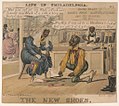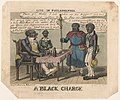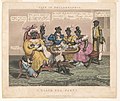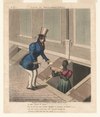Life in Philadelphia (Tregear)
Tregear's first series was published in 1833 under the name "Life in Philadelphia." This was the same name that had been used by American illustrator Edward Williams Clay for his 1828-1830 cartoon series, published in the United States. "The cartoons were so popular that the term Life in Philadelphia became a standard phrase to refer to fashions, trends, and—most especially—black Philadelphians' social practices and sartorial choices." [1] : 137 In 1831, British illustrator William Summers redrew and enlarged ten of Clay's cartoons, which were engraved by Charles Hunt, and issued as color lithographs by London publisher Harrison Isaacs.
Of the twelve cartoons in Tregear's initial series, Summers designed and drew nine, two were reissues of Clay cartoons redrawn by Summers (from Isaacs), and Charles Hunt engraved all eleven as lithographs. [2] The last cartoon was credited as "Drawn & Engraved by I. Harris." "I. Harris" is now accepted as a pseudonym for Edward Williams Clay himself. [3] Another eight of the Clay cartoons redrawn by Summers (from Isaacs) were soon reissued to expand the first Tregear series to twenty plates. [4]
While the successful transfer of Clay's cartoons was attributable in part to the shared cultural backgrounds and common understandings of London and Philadelphia, the London cartoons took on a new meaning and form. London artists like Isaacs, Summers, Hunt, and Tregear made changes that signposted shifts in the cartoons' meanings, exaggerated the features of Philadelphian blacks even more grotesquely than had Clay, rendering them more bestial in anatomy and features. [1] : 145
| Plate | Title | Image | Artist | Publisher | Year | Captions | Notes |
|---|
| No. 1 | Dark Conversation |  | William Summers | G. S. Tregear,
London | c.1833 | "Bery Black looking day dis Mons'r."
"Yes Bery stormy. De Blacks flying about so make it Petickly Disagreable." | |
| No. 2 | An Unfair Reflection | | William Summers | G. S. Tregrear,
London | c.1833 | "It was bery Unfair ob Mifs Carolina to Reflect on de Palenefs ob my
Complexion. I consider dat I hab got a bery Good Color." | |
| No. 3 | The New Shoes |  | William Summers | G. S. Tregear,
London | c.1833 | | |
| No. 4 | The Lub Letter |  | William Summers | G. S. Tregear,
London | c.1833 | | |
| No. 5 | A Black Charge |  | William Summers | G. S. Tregear,
London | c.1833 | "Please y-'r Worship I hab taken up dis Nigger!! case he-'s -nebriated and
-sulting to de Fair sec." | |
| No. 6 | The Valentine |  | William Summers | G. S. Tregear | c.1833 | "Holl'a! What's all dis about—
'De rose is Red de Violets blue'
'De Debil's Black and so are You.'
Well dat's bery Fair indeed." | |
| No. 7 | A Black Tea Party |  | William Summers | G. S. Tregear,
London | c.1833 | | |
| No. 8 | How you find yourself dis hot Weader
Mifs Chloe? |  | "Engraved by Charles Hunt"
(after Edward William Clay) | Harrison Isaacs,
London | c.1831 | | |
| No. 9 | Have you any Flesh coloured Silk
Stockings, young Man? |  | "Engraved by Charles Hunt"
(after Edward Williams Clay) | Harrison Isaacs,
London | c.1831 | | |
| No. 10 | A Black Ball |  | William Summers | G. S. Tregear,
London | c.1833 | | |
| No. 11 | Grand Celebration ob de Bobalition
ob African Slabery |  | Drawn & engraved by I. Harris
(Edward Williams Clay) [3] | G. S. Tregear,
London | 1833 | | |
| No. 12 | Romeo and Juliet |  | William Summers | G. S. Tregear,
London | c.1833 | ROMEO._"How Silber sweet, sounds Lubbers Tongues by Night; like
sorptest Music to attending Ears."
JULIET._"Dou know'st de mask ob night is on my face, else would a
maiden blush bepaint my cheek." | |
Additions
In 1831, William Summers and Charles Hunt copied ten cartoons from Edward Williams Clay's Life in Philadelphia series for publisher Harrison Isaacs. [2] Tregear's version of Life in Philadelphia initially reprinted two of the cartoons from Isaacs, but soon added eight more, bringing its number of plates to twenty. [4]
At least two alternate cartoons, copied from Clay, were reissued by Tregear under the name "Life in Philadelphia."
| Plate | Title | Image | Artist | Publisher | Year | Captions | Notes |
|---|
| No. 13 | A Crier Extraordinary | | "Engraved by Charles Hunt"
(after Charles William Clay) | Harrison Isaacs,
London | c.1831 | | |
| No. 14 | What you tink of my new Poke bonnet,
Frederich Augustus? |  | "Engraved by Charles Hunt"
(after Charles William Clay) | Harrison Isaacs,
London | c.1831 | | |
| No. 15 | Hurrah! Hurrah for General Jackson!! |  | "Engraved by Charles Hunt"
(after Charles William Clay) | Harrison Isaacs,
London | c.1831 | | |
| No. 16 | Shall I hab de honour to dance the next
quadrille wid you, Mifs Minta? |  | "Engraved by Charles Hunt"
(after Charles William Clay) | Harrison Isaacs,
London | c.1831 | | |
| No. 17 | Is Mifs Dinah at Home? |  | "Engraved by Charles Hunt"
(after Charles William Clay) | Harrison Isaacs,
London | c.1831 | | |
| No. 18 | How you like de new fashion shirt, Mifs
Florinda? |  | "Engraved by Charles Hunt"
(after Charles William Clay) | Harrison Isaacs,
London | c.1831 | | |
| No. 19 | Take away dose rosy lips. |  | "Engraved by Charles Hunt"
(after Charles William Clay) | Harrison Isaacs,
London | c.1831 | | |
| No. 20 | How do you like the waltz, Mr. Lorenzo? |  | "Engraved by Charles Hunt"
(after Charles William Clay) | Harrison Isaacs,
London | c.1831 | | |
| Alternates |
| The Cut Direct: or How
to get up in the World |  | unidentified
(after Edward W. Clay) | W. H. Isaacs,
London | c.1832 | | |
| Sketches of Character:
At Home and Abroad | | H. Harrison
(after Edward W. Clay) | W. H. Isaccs,
London | c.1833 | | |
This page is based on this
Wikipedia article Text is available under the
CC BY-SA 4.0 license; additional terms may apply.
Images, videos and audio are available under their respective licenses.








































